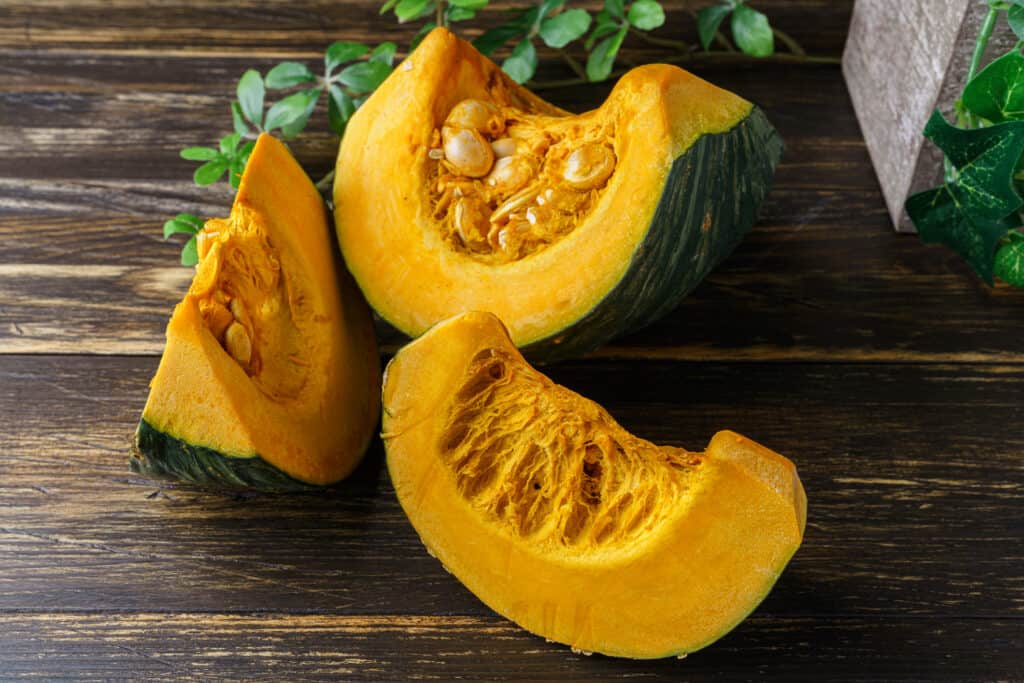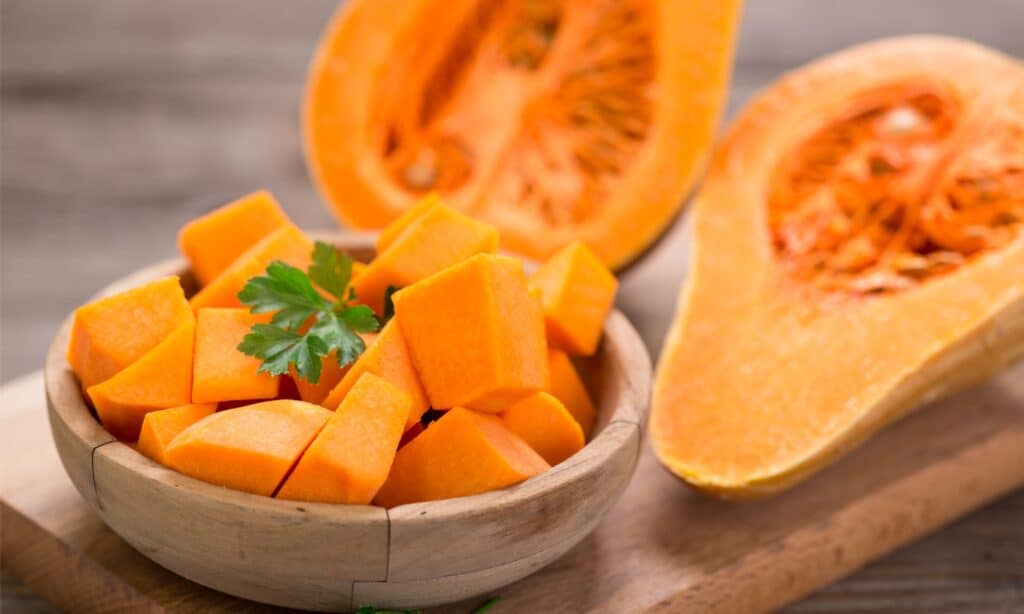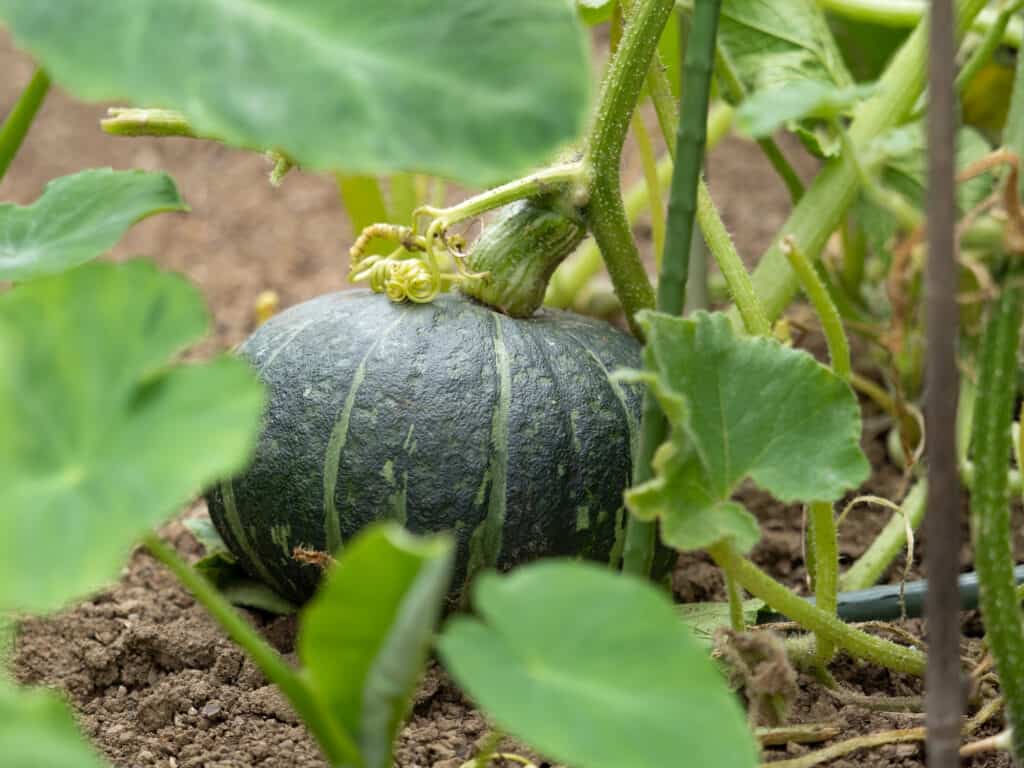Have you heard of kabocha? It’s a type of winter squash that’s rapidly gaining popularity. It can be used instead of our tried and tested butternut squash, but what exactly is the difference? Let’s take a closer look at these two squash plants to find out how they differ.
Key Differences Between Kabocha and Butternut Squash

Kabocha tastes like a cross between pumpkin and sweet potato.
©iStock.com/Wako Megumi
The main differences between kabocha and butternut squash are their appearance and the taste of the squash fruit. Kabocha is squat, rounded and dull green with white stripes or mottles, whereas butternut squash is bell-shaped with a long neck and colored pale tan-orange. There’s no mistaking them by sight!
Another difference is the taste. Many of us have eaten roasted butternut squash. It’s deliciously creamy and nutty and a real treat, but kabocha goes a step further. It’s flesh is firmer so it better holds together under heat, and it’s sweeter. Many folks describe it as a cross between pumpkin and sweet potato. It has more of nutty kick to it than butternut squash.
| Kabocha | Butternut Squash | |
|---|---|---|
| Name | Kabocha (Cucurbita maxima var. kabocha) | Butternut Squash (Cucurbita moschata var. Butternut) |
| Other names | Japanese Pumpkin | Calabasa, Calabaza, Crookneck Squash |
| Shape | Rounded, squat | Bell-shaped |
| Taste | Creamy, sweet and nutty firm flesh | Less intense, holds more water |
| Color | Green and white skin, orange flesh | Tan-orange skin, orange flesh |
| Foliage | 12 feet vines, hairy rough green foliage with bright yellow trumpet flowers | 12 feet vines, hairy green foliage with bright yellow trumpet flowers |
| Growing Zone | 2-11 | 2-11 |
| Toxic to Dogs | Not toxic | Not toxic |
Kabocha
Kabocha is a rounded green winter Cucurbita maxima squash in the cucurbita family with tasty orange flesh. It’s more commonly called kabocha squash or Japanese pumpkin.
It’s pronounced ka-bo-tcha.
Butternut Squash
Butternut squash is a Cucurbita moschata winter squash with orange flesh and smooth pale orange skin. It has a distinctive neck and rounded body.
History and Origins of Squash

Butternut squash was developed in 1944 and is a cross between a gooseneck squash and a Hubbard squash.
©iStock.com/chengyuzheng
Today’s squash plants descend from the original squash plants that were native Mesoamerica. Researchers have found evidence suggesting humans have cultivated them for at least 10,000 years, that’s thousands of years before maize and other cereal crops.
Kabocha is called Japanese squash but it’s not native to Japan. It was first traded there in 1541 most likely by the Portuguese who called it Cabaca and Camboja abobora because they first encountered it in Cambodia, Asia. The Japanese shortened camboja abobora to kabocha.
Butternut squash’s original form was the squash Cucurbita moschata. The butternut squash we know today is a recent cultivar that was developed in 1944 by crossing gooseneck squash with Hubbard squash.
Growing Zones for Kabocha and Butternut Squash
Kabocha and butternut squash grows in USDA Zones 2-11, so it’s an accessible plant that the majority of gardeners can grow successfully.
Kabocha vs. Butternut Squash: Do They Taste Different?
Not only do these two squashes look totally different unpeeled they taste different too!
Kabocha is creamier and firmer than butternut squash and it has firmer flesh. It tastes similar to a mix of sweet potato and pumpkin. Butternut squash is more pumpkin-tasting and has less consistency.
Cooks prefer to use kobocha when the recipe calls for a firm texture or a sweeter flavor. Kobocha is quickly becoming a popular alternative to butternut squash.
Can You Eat Kabocha Skin?
Yes kabocha skin is edible, it can be a little tough compared to the soft flesh, but if it’s cooked slowly for a little longer there’s no need to peel it. You can eat butternut squash skin too. In fact, the majority of squashes have edible skin that hold a good amount of vitamin A.
Kabocha vs. Butternut Squash: Appearance

Both kabocha and butternut squash both of deep orange flesh that is sweet and nutty.
©iStock.com/pilipphoto
These winter squashes look very different in appearance.
Kabocha is rounded and dark green with white mottled stripes whereas butternut is tan-orange. The shape is also totally different. Whereas butternut squash has a rounded flowering end with a long neck, kabocha is round, squat, and a little wider than it is tall.
Butternuts usually measure around nine to 18 inches in length but kabocha only reaches around 12 inches.
It’s impossible to mistake the two unless they are chopped and prepared without the skin on because both squashes have rich deep orange flesh. Kabocha flesh is little deeper orange than butternut, but it’s hard to tell the difference unless you eat it.
Kabocha vs. Butternut Squash: Foliage

All squash varieties have similar foliage with large green, heart-shaped leaves and trailing vines.
©iStock.com/y-studio
The fruits may look different but the foliage is very similar. In fact, most squashes, pumpkin, and zucchini leaves look the same.
Squash plants have a long hairy vine that creeps across the soil or up and over a trellis. They produce climbing tendrils to anchor themselves in place.
Kobocha and butternut squash have large green leaves that are heart-shaped with three distinct sections. If you touch them, their fuzzy hairs are quite sharp in order to deter pests like snails. Both plants produce vines that can reach up to 12 feet and branch out to create further fruiting vines. They need a lot of room to grow to their full potential.
Squash foliage is very susceptible to mildew, so it’s important to plant them several feet apart for good air circulation and only water their roots, not the foliage.
Can You Eat Squash Flowers?
Yes, you can eat kabocha and butternut squash’s funnel-shaped orange flowers, including the green base. They are mild tasting, but delicate and quite flavorsome. Deep fried or stuffed squash flowers are popular in southern Europe where they are called squash blossom fritters.
If you want to pick some flowers to eat, look for male flowers that won’t mature into squashes. They won’t have swelling behind the flower, but female ones do. This is the baby squash!
When To Harvest Kabocha Squash
Harvest butternut squash and kabocha when they have matured. This is when they have hard skin and a firm stalk. But wait! After harvesting it’s best to leave them to mature even further because they develop a much richer flavor after a few months.
Store them somewhere cool and dry and ensure no parts are touching just in case one is infected.
You can eat squashes straight from the vine, but they are bland and lack that nutty creamy taste.
Are Squash Annuals or Perennials?
Kabocha and butternut squash are annuals. This means they germinate, grow, and set seed in one year.
Squash seeds are planted out in early spring and start to produce flowers that quickly turn into fruit in midsummer. Squashes are harvested in the fall, but in tropical Zones, squash vines can flower in a second year if they are well fed.
Can I Substitute Kabocha for Butternut Squash?
Yes, anything butternut squash can do, kabocha can do too. It’s firmer and sweeter, so you may need to add less flavoring.
How To Grow Butternut Squash vs. Kabocha
Both species are grown the same way, so why not have a go at both?
First, select your site. It should get plenty of sunlight and not be overcast by buildings or trees. The next step is to bulk up the soil. Squashes are hungry plants, in fact, we could say they are starving.
Squash and others in the family like pumpkins and zucchini greedily eat and drink all the water and fertilizer you can provide. It’s hardly surprising considering they grow from a ½ inch seed into a 12-feet long vine with huge leaves, numerous flowers, and full-size fruit within 60 days!
Now we’re ready to plant:
- Push one seed into the soil when frosts have passed. Alternatively, start your seeds off on a warm sunny windowsill and transplant them in spring
- Each squash plant needs room, so space them three feet apart. This seems like overkill but once they reach full size you’ll see why!
- When they sprout, keep watering and weeding
- When the first flowers appear fertilize once a week with a liquid feed
- Trim off excess shoots so all the nutrients go into ripening just five or six squash fruits
Some gardeners like to grow squash vertically. It’s a good idea if you have little space or lots of slugs and snails. A simple trellis or nearby shrub will do the trick, but it must be sturdy enough to support the weight of several squash fruits.
Is Kabocha or Butternut Squash Best?
This is a difficult question to answer because they are both tasty fruits with lots of vitamins, especially vitamin A, and they can both be roasted, stewed, casseroled, or used in any number of different dishes.
The best one is of whichever you most like the look and taste.
Up Next
- Butternut Squash vs. Pumpkin: What are the Differences?
- Can Dogs Eat Butternut Squash Safely? What Science Says
- Butternut Squash vs Sweet Potato: What’s the Difference?
The photo featured at the top of this post is © iStock.com/karimitsu
Sources
- Korean Journal of Food Science and Technology, Available here: https://koreascience.kr/article/JAKO200709905802961.page
- Science Reference Section, Library of Congress, Available here: https://www.loc.gov/everyday-mysteries/agriculture/item/how-did-squash-get-its-name/#:~:text=Squashes%20are%20one%20of%20the,both%20South%20and%20North%20America
- Bill Kerr, Available here: https://www.farmersweekly.co.za/crops/vegetables/the-strange-history-of-the-butternut/
Thank you for reading! Have some feedback for us? Contact the AZ Animals editorial team.






